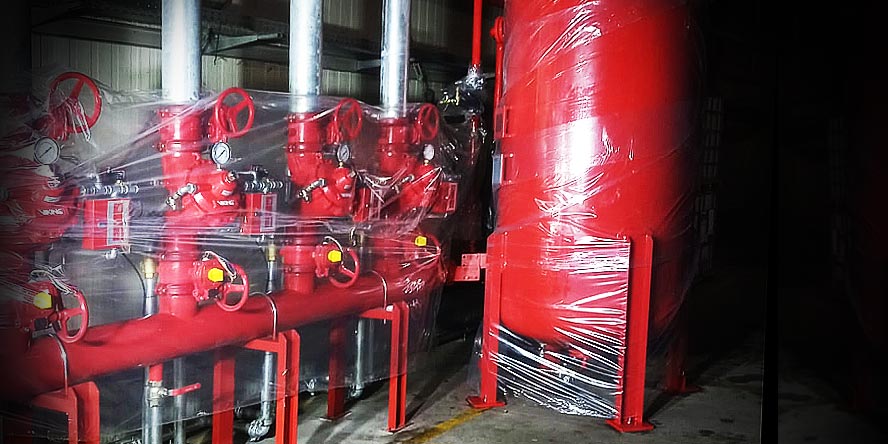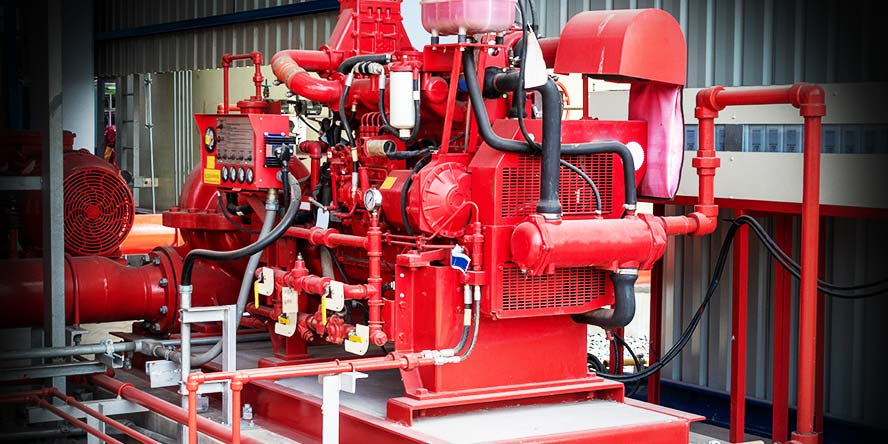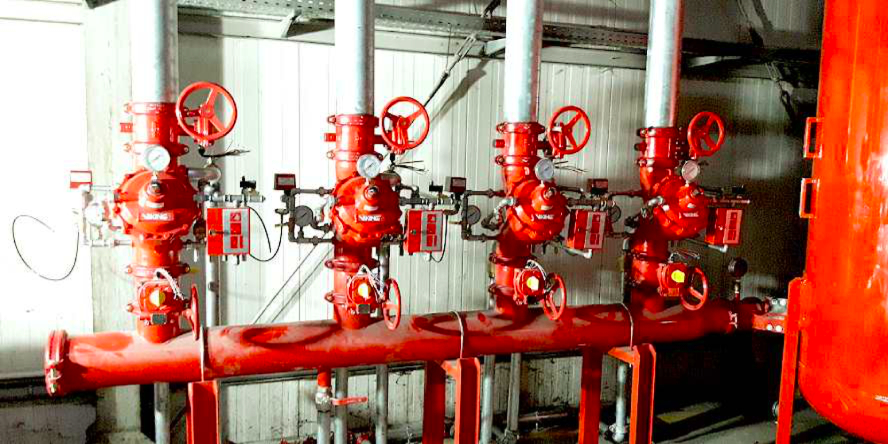Problem:
- According to the fire protection report, it is necessary to install a fire extinguishing system.
- The weight of a water-based installation exceeded the structural strength of the hall roofs.
- The investor required the footprint of the fire water tank and the pumping station to be reduced.
Solution:
- We have implemented a foam-based fire extinguishing system with a foam tank and dosing system, which reduced water consumption by 30%.
- This allowed us to reduce the weight of the installation fixed to the roofs of the halls, as well as the size of the fire water tank and that of the pumping station.
Cooperation with a fire safety expert
Lighter system to avoid excessive load on the hall structure
Smaller pumping station and water tank
A fire protection report prepared by the fire safety expert demonstrated that the waste processing plant did not meet all of the fire safety requirements. As a result, it was necessary to ensure the safety of two halls with a total area of 1024 m2, where waste (mainly paper and plastic) was sorted and stored. Specifically, the fire extinguishing system was to cover 8 large waste bunkers and one of the walls of the building. The latter was necessary in order to protect an adjacent plant, which was too close to the waste processing facility.
The turnkey project included the following:
- Design, installation and commissioning of the fire extinguishing system
- Obtaining permits, expert opinions and approvals (acceptance of the project by a fire safety expert, inspection of the soil where the fire water tank and the pumping station were to be installed, evaluation on the strength of roofs of the halls, a building permit, acceptance inspection by the State Fire Service)
How to reduce the footprint of the fire water tank and the pumping station
The customer wanted to minimize the size of the fire water tank and of the pumping station. They were to be installed in a location, where intensive works are carried out on a daily basis using excavators, including long-reach excavators. A large footprint of the aforementioned installations would increase the risk of collision, which was unacceptable for the investor.

Flood installation of a foam-based fire extinguishing system
For this reason, the customer’s original concept based on using water as the fire extinguishing medium was changed to an installation based on the use of the so-called foam cannons. This solution reduced the required volume of the fire extinguishing medium to be poured onto the fire by more than 50%. This translated into reduced water consumption for the customer and by the same token allowed us to use a water tank and a pumping station with reduced footprint.
To save even more space, we decided to use a small-size container pumping station.
Can the weight of a fire extinguishing system cause damage to the structure of the hall?
These are not the only advantages of using foam cannons. According to the calculations, a typical fire extinguishing system with water sprinklers would weigh as much as 16 tons when activated. This weight would have far exceeded the structural strength of the roofs of both halls to which the installation would be attached, posing the risk of damage to their structure. In extreme cases, the halls could collapse.
This has been confirmed by appropriate calculations which took into account other factors, such as the impact of wind and snow.

Diesel pump for a fire extinguishing system. A similar pump has been used in the project described herein.
The scope of completed works:
- A detailed design of a system based on the use of foam cannons
- An outdoor fire water tank with the capacity of approx. 350m3, including foundations
- A container pumping station with a diesel pump, a foam tank, fittings and equipment
- Connecting the pumping station building and the hall to the fire protection network via PEHD pipes
- Providing water supply to the fire water tank
- Routing power cables from the transformer station to the fire pumping station
- A splitter with electrically activated flooding stations
- A system of pipes, fittings, nozzles with fixtures and a fastening system
- Installation, system commissioning and training
NOTE: the following text comes from an article written by Mateusz Świtała, a Fire Protection Department Manager at WOLFF GROUP, titled “Fire risks in a waste sorting plant“. Which safety devices should be used and why? If you want to learn about the reasons behind fires in waste sorting plants and how to prepare for an investment in a fire protection system, please click on the following link:
Which safety devices are suitable for a waste sorting plant?
So far, fires at sorting plants and waste collection points have demonstrated very clearly how dangerous these facilities can be in case of a fire. Fire spreads rapidly and quickly occupies a large area. During a fire, a lot of poisonous smoke is generated, which is always potentially dangerous to the surrounding environment. Due to the heterogeneous type of combustible materials, it is never possible to determine, in which direction the fire will spread and whether there will be additional explosions. That is why it is so important to protect these installations with suitable fire prevention systems. The question is, which should we choose?
- Special sprinkler systems designed specifically for extinguishing fires in storage halls should be used.
- Water extinguishing systems are ineffective in such conditions. Melting plastics, which constitute a large portion of the waste found at sorting plants, form a kind of a “shell” which prevents water from reaching the inside of the waste heap.
- In contrast, extinguishing such fires with foam is effective, because foam reaches deeper layers of waste, where the fire often spreads.
- A reduced footprint of the water tank is yet another advantage resulting from using foam. Such systems are typically characterised by a maximum use of the available space and therefore, a smaller tank, which, at the same time meets all the applicable fire safety requirements, is often appreciated by the investor.
Suitable smoke and temperature detectors, or even thermal imaging cameras, are vital for the early detection of danger. They will allow the system to initiate extinguishing as quickly as possible. However, with smoke detectors, there is a risk that dust and particulates accumulated in large volumes can often trigger false alarms.





